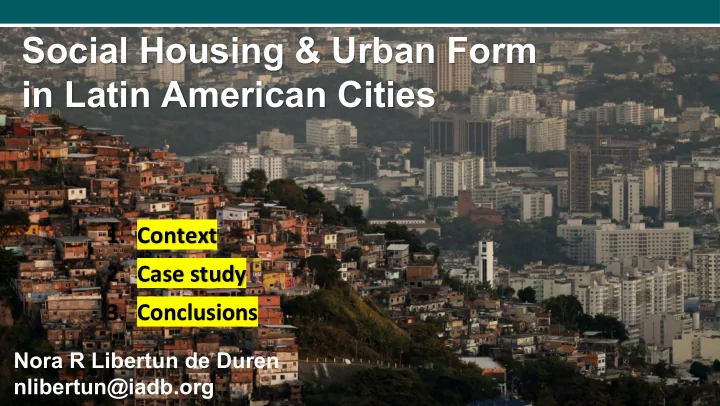

Social Housing & Urban Form in Latin American Cities 1. Context 2. Case study 3. Conclusions Nora R Libertun de Duren nlibertun@iadb.org
Context 1960’s 2010’s Rural to Urban Migration Urban to Rural Expansion Source: Sebastiao Salgado_ Amazonas Pictures
Urban areas grew faster than urban population Urban Area 4 % 2 % Urban Population 2010 2025 1960 Source: Own elaboration based on UN Habitat 2014, State of Cities ; and Angel et al, 2011. The Dynamics of Global Urban Expansion
The urban footprint is rapidly expanding Santiago de Chile Sao Paulo, Brazil Ciudad de Mexico
1960’s: informal settlements as peripheral places Average density 60o residents/ha
2010’s: social housing in urban peripheries Average density 40o residents/ha
% area of the urban periphery by land use (1960-2010) 100% Remaining area 90% Shantytowns 80% Social Housing 70% 60% 50% Gated … Rural uses 40% 30% 20% 10% City 0% 1960 1970 1980 1990 2000 2010
Current state of Latin American Cities Bogotá. Fuente: Caracol Radio High levels of informality Uneven access to urban services 32% Urban residents live in informal neighborhoods 55 million Lack access to adequate housing 57% Of urban residents work in the informal economy Inequality Latin-American cities are the most unequal in terms of coverage & quality of services
HOUSING demand in Latin American Cities
HOUSING demand in Latin American Cities Qualitative Quantitative (
HOUSING Subsidies in Latin American Cities Qualitative Quantitative Qualitative
Urban outcome
Case study MEXICO DEFICIT 7% Quantitative 93% Qualitative (10m urban households SUBSIDIES 6% repairs to existing units 94% credit for new units (+55million usd)
# of Housing Units sold per year Fed. Government annual target: 750k social housing units
Social housing geography 25% housing units were built after 2000 11% of units were built on the 1 st ring of the urban periphery 87% of units were built on the 2 nd ring of the urban periphery 22 Km average distance to downtown
Social Housing spatial rationale Puebla Peripheral vs Central Social 26,600 US$ housing Development +Interviews to developers +review policy instruments 37,000 US$
Social Housing spatial rationale Peripheral vs Central ECONOMIES OF SCALE Average company size 500+ vs 70 employees Portfolio All vs only social housing
Social Housing spatial rationale Peripheral vs Central COST STRUCTURE: land + infrastructure 30% land infrastructure
Social Housing spatial rationale Peripheral vs Central COST STRUCTURE: Economies of scale 10% savings with 500+ units More negotiation power Small vs big municipalities…
Social Housing spatial rationale National programs determine Funding structure Architectural standards Municipal governments determine Land use
Conclusions The challenge of cities today is the expanding urban fringe , not the growing urban population.
Conclusions Central and Peripheral Social Housing Developers Have similar cost structures Gain is based on -economies of scale & -power asymmetries
National Policies Mismatch between need and demand (subsides for new vs improved) Subnational policies Push social housing to periphery Lack metro coordination leads to expanded urban footprint
Suggestions PROACTIVE ü Match subsidies to demand ü Support rental housing & improvement programs ü Increase urban densities & metropolitan planning ü Limit maximum social housing complex size
Suggestions REACTIVE ü Support jobs in peripheries ü Improve transport connections ü Develop public spaces of quality ü Facilitate legal processes ü Improve environmental performance
Thank you! Nora R Libertun de Duren nlibertun@iadb.org
Recommend
More recommend